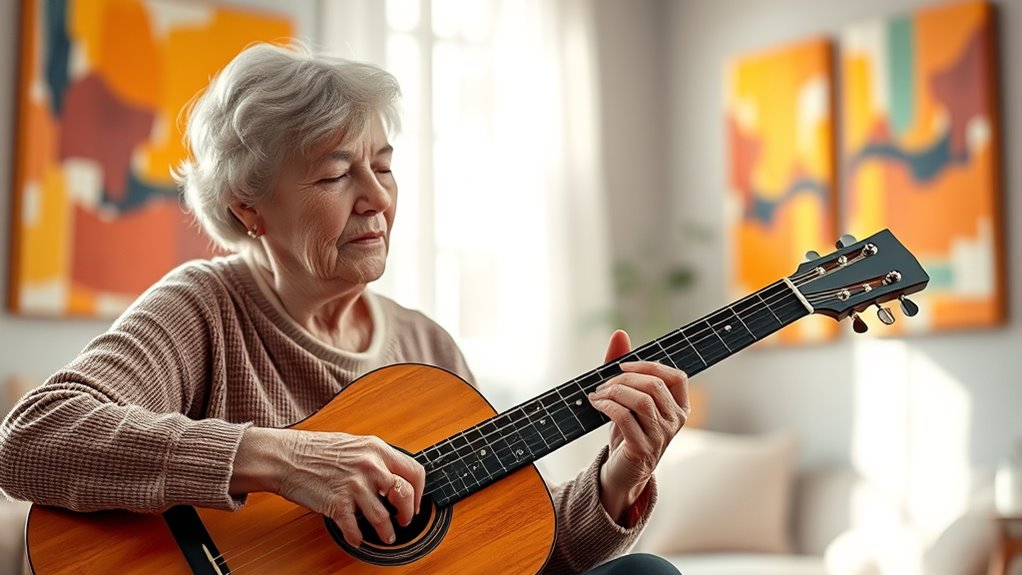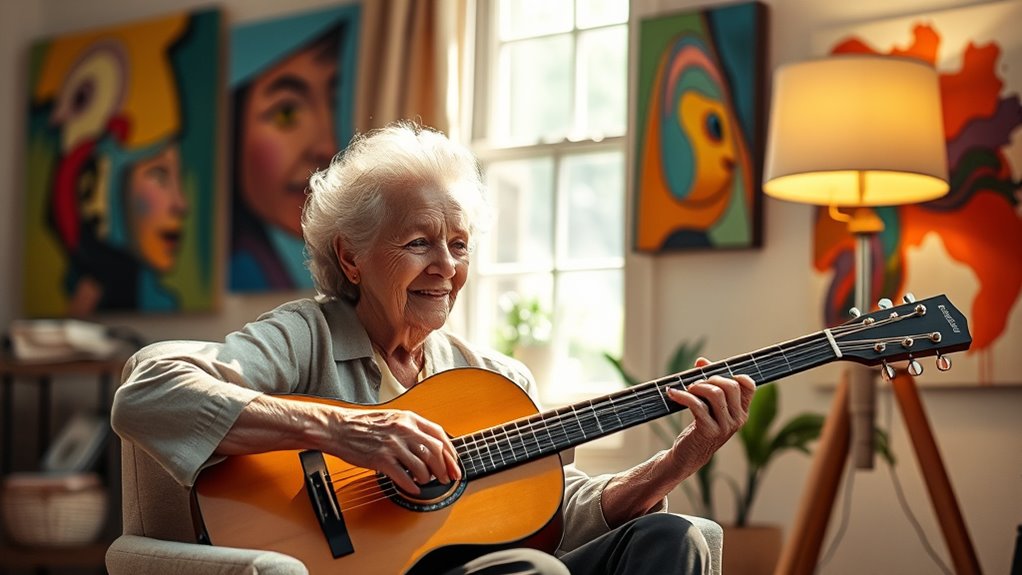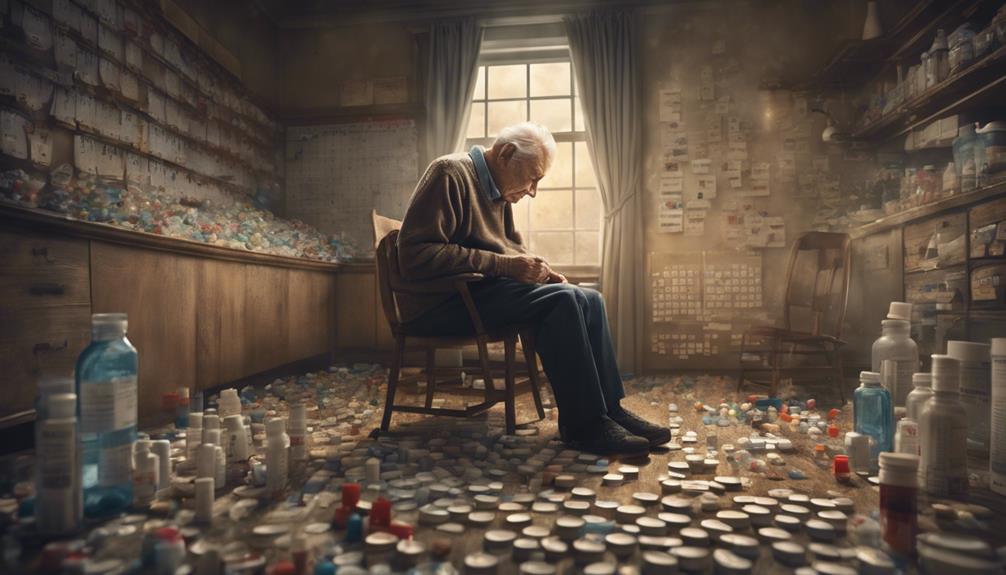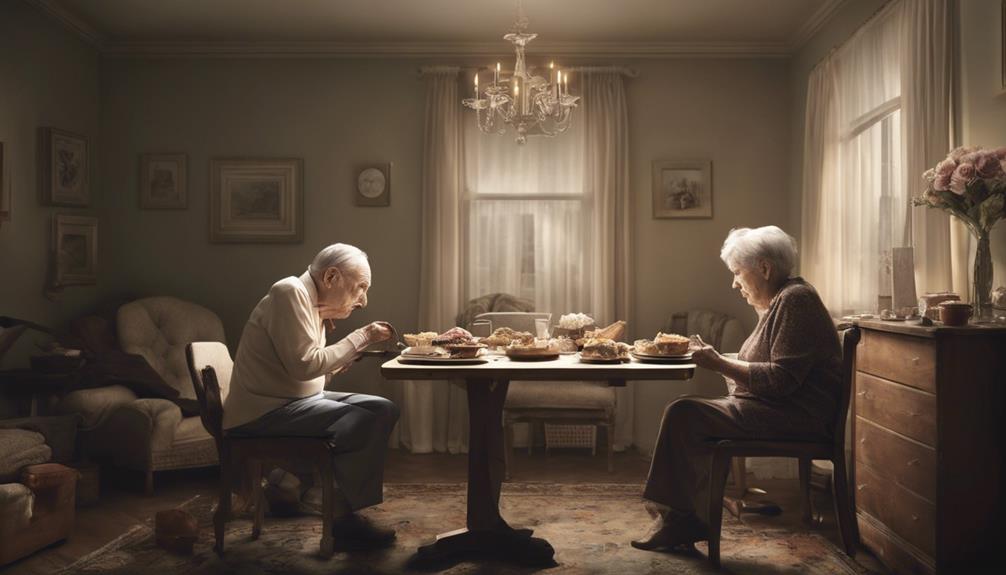Music and art therapy provide gentle, accessible ways to soothe dementia-related agitation. Playing familiar music or creating art with your loved one can trigger positive memories, promote relaxation, and reduce feelings of anxiety. These activities help redirect focus and foster emotional connections, often with minimal resources or specialized training. Incorporating personalized music or visual stimuli makes the calming effects even stronger. If you keep exploring, you’ll discover practical ways to bring these comforting approaches into daily life.
Key Takeaways
- Music therapy with familiar melodies reduces agitation, triggers positive emotions, and promotes calmness in dementia patients.
- Visual arts activities provide non-verbal self-expression, distraction, and joy, helping to lessen agitation.
- Personalizing music and art activities with preferences deepens their calming effects and enhances emotional connection.
- These therapies are low-cost, simple to implement, and can be integrated into daily routines for consistent benefits.
- Overall, they improve well-being, restore connection, and empower caregivers to support emotional stability effectively.

Dementia can lead to agitation and anxiety that disrupt daily life, but music and art therapy offer effective, non-pharmacological ways to calm and connect with those affected. As someone caring for a loved one with dementia, you might notice sudden outbursts or restlessness that seem hard to control. Engaging in music therapy can help ease these symptoms by providing familiar melodies or soothing rhythms that resonate deeply. When you introduce music, it can trigger positive memories and emotions, helping your loved one feel more centered and less overwhelmed. You don’t need special training; simply playing gentle tunes or singing along can make a considerable difference.
Music therapy with familiar melodies can soothe agitation in dementia.
Similarly, visual arts—such as drawing, painting, or looking at calming images—serve as powerful tools for reducing agitation. Art therapy encourages self-expression without the need for words, which is especially helpful as language skills decline. You can set up a simple art station with supplies like colored pencils, paints, or even collage materials. Watching your loved one create or observing their reactions to visual arts can foster a sense of accomplishment and joy. These activities also act as distractions from distressing thoughts or feelings, redirecting their focus to something soothing and engaging.
Both music therapy and visual arts are versatile and adaptable to individual preferences. For example, if someone reacts positively to classical music, you can incorporate that into their routine. If they enjoy vibrant colors or familiar images, you can use these in visual arts activities. The key is personalization: choosing what resonates most with your loved one helps deepen the calming effect. These therapies also promote a sense of connection, breaking through the barriers of dementia and fostering emotional bonds. When you participate together, it reinforces feelings of safety and understanding.
Another advantage of these therapies is that they’re low-cost and accessible. You don’t need expensive equipment or professional training to get started. Simple music playlists or printed images can be enough to create a calming environment. Additionally, understanding the hours of operation of local stores can help you plan your shopping trips more efficiently, ensuring you have the necessary supplies on hand. Regularly integrating music and visual arts into your loved one’s routine can markedly reduce episodes of agitation and promote a peaceful mood. This approach empowers you to take an active role in their well-being, offering comfort and familiarity in ways that medication often cannot provide. Ultimately, these creative therapies help restore a sense of normalcy and connection, making daily life more manageable and meaningful for both of you.
Frequently Asked Questions
How Do Music and Art Therapy Compare in Effectiveness?
You’ll find that music and art therapy are both effective for reducing dementia agitation, but they work differently. Music therapy boosts emotional expression through familiar sounds and rhythms, engaging your senses and calming your mind. Art therapy allows you to express feelings visually, providing sensory engagement and emotional release. Both foster connection and relaxation, yet the choice depends on your preferences and specific needs for emotional and sensory engagement.
Can These Therapies Be Used at Home Without Professional Guidance?
You can definitely use music and art therapy at home with proper caregiver training. For example, you might create a daily music playlist to calm your loved one, or set up simple art activities. Home-based interventions work best when you learn techniques from a professional, so consider caregiver training to guarantee you’re providing safe, effective support. This approach empowers you to help reduce agitation without needing a therapist present.
What Types of Music or Art Are Most Beneficial?
You should choose music that matches your loved one’s preferences, such as favorite songs, calming melodies, or gentle tunes. For art, opt for familiar art mediums like drawing, coloring, or simple crafts they enjoy. Using their preferred music and art mediums helps create a soothing environment. Pay attention to their reactions and adjust accordingly, ensuring the activities feel comfortable and engaging for them.
Are There Any Risks or Contraindications?
You should be aware that therapy safety is essential, and some individuals might have allergies or sensitivities to certain materials or sounds. Always follow caregiver guidance to monitor your loved one’s reactions closely. Avoid forcing participation if they become distressed, and consult professionals if you notice adverse effects. Proper supervision guarantees that music and art therapy remain beneficial, minimizing risks and enhancing comfort for your loved one.
How Do These Therapies Impact Overall Quality of Life?
Did you know that engaging in music and art therapy can improve emotional well-being for people with dementia by up to 70%? These therapies enhance overall quality of life by reducing agitation, boosting mood, and fostering social connections. You’ll notice your loved one feeling more engaged, happier, and less isolated. By supporting their emotional and social needs, these therapies create a more positive, fulfilling daily experience.
Conclusion
As you consider these therapies, remember they hold more power than you might realize. Imagine a moment where a patient’s agitation fades, replaced by a gentle smile or a calming gaze. Could music and art be the key to unfastening peace in their mind? The answers may lie just beyond your reach, waiting to transform lives in ways you never expected. Are you ready to discover what these healing arts can truly do?









